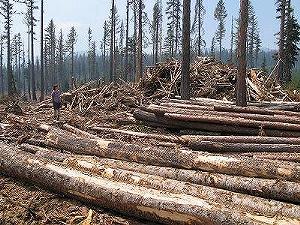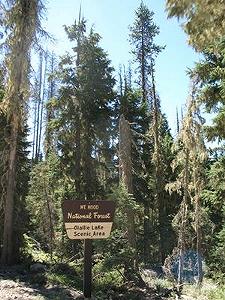How Does Wyden's Draft Legislation Impact Mt. Hood
Senator Ron Wyden (D-OR) unveiled a draft legislative proposal – the “Forest Restoration and Old Growth Protection Act.” See what Bark thinks about it.

Logging in Eight Mile Meadow, a Categorical Exclusion, or CE, on Mt. Hood National Forest

Forests in the Olallie Lake Scenic Area that will be logged and used for biomass
In June 2008, Senator Ron Wyden (D-OR) unveiled a draft legislative proposal – the “Forest Restoration and Old Growth Protection Act.” The proposal and other resources are available on Senator Wyden’s website at www.wyden.senate.gov/forestproposal. Senator Wyden’s office is requesting public input and we hope the following summary will help citizens provide feedback.
The draft legislation is proposing changes that are limited to federal forest lands in the state of Oregon. Although these forests are currently managed under the Northwest Forest Plan, a regional plan that encompasses Washington and northern California, Oregon’s old-growth forests have continued to face heavy logging and are more imminently threatened. The proposal has three major components that impact Mt. Hood National Forest and Bark’s work to protect federal forestlands around Mt. Hood; permanent protection of old-growth trees, decreased levels of public participation, and increased size and scope of thinning logging projects.
OLD-GROWTH PROTECTION
The proposal would prohibit the logging of trees older than 120 years in “moist” forests and 150 years in “dry” forests. Currently, under the Northwest Forest Plan, old-growth stands are protected outside Wilderness if they are older than 80 years and fall in a Late-Successional Reserve (LSR). Although this change would raise the age, protecting less within LSRs, it would apply throughout the forests, including the areas that are heavily-logged which are referred to as Matrix Lands. While there is not scientific agreement that any logging should be occurring in LSRs, there is overwhelming public and scientific consensus that ALL old-growth should be protected, and this provision is a significant step in the right direction.
PUBLIC PARTICIPATION
Bark is built on the common value that the public should be a part of public lands decision-making. We not only get people into the forest to learn about the forest and the threats it faces, but also train and support citizens through the public participation process created under the National Environmental Policy Act (NEPA). Senator Wyden has been consistently vocal about his opposition to this process, claiming that it is too lengthy and costly to taxpayers. The draft proposal encourages the agencies to move away from the NEPA process in two ways:
1.By increasing the use of Categorical Exclusions (CEs) which allow the agency to forego any environmental review and appeal, limiting the amount of information the public receives about a logging project proposal. Currently CEs are no more than 70 acres for regular logging projects and up to 250 acres for salvage sales. In this proposal, CEs would vary from 10,000 to 50,000 acres (16 to 78 sq. miles).
2.Extending the use of “collaboration” groups. These groups are made up of selected local representatives from an array of interest groups and government entities. Currently, they have the ability to approve or deny a project and can be for a one-time project or on-going from project to project. Mt. Hood National Forest has had five one-time collaborative groups and one long-term group, the Clackamas Stewardship Partners. Bark has cautiously participated in collaboration, with most of our experience coming from the Clackamas Stewardship Partners. Although these groups can be strong, outspoken advocates for restoration, their exclusivity from most citizens who do not have the time to attend regular weekday meetings is a concern to Bark.
INCREASE IN LOGGING
Senator Wyden’s proposal emphasizes restoration. The proposal also intends to allow for expedited, large-scale thinning. “Restoration” logging has been a controversial issue within public lands management. Mt. Hood National Forest has been at the forefront of this controversy. Whether logging to pay for restoration projects in another part of the forest or attempting to use commercial logging to achieve restoration goals in a forest, this legislative proposal rapidly propels the idea that land managers will be able to strike a balance between what makes money and what is good for the ecosystem. Bark has seen large-scale thinning proposed and implemented on Mt. Hood and does not believe this balance exists through the commercial logging program.
In addition, the proposal includes language regarding biomass. The Forest Service would be authorized to enter into 20-year contracts to provide wood fiber to supply the production of cellulosic ethanol for fuel. In 2007, Mt. Hood National Forest announced the forest’s first biomass project, logging in the popular Olallie Lakes Scenic Area and in proposed wilderness. Bark is gravely concerned about the future of public lands and the growing demand for domestic energy supplies. We depend on our forests and waterways for other important resources such as drinking water. Our remaining public lands forests are not acceptable sources for our excessive energy demands.
For more information, please contact the Bark office by calling 503-331-0374 or emailing Amy Harwood at amy (at) bark-out.org. Thanks to Mike Anderson with The Wilderness Society for help with compiling the information provided.
The draft legislation is proposing changes that are limited to federal forest lands in the state of Oregon. Although these forests are currently managed under the Northwest Forest Plan, a regional plan that encompasses Washington and northern California, Oregon’s old-growth forests have continued to face heavy logging and are more imminently threatened. The proposal has three major components that impact Mt. Hood National Forest and Bark’s work to protect federal forestlands around Mt. Hood; permanent protection of old-growth trees, decreased levels of public participation, and increased size and scope of thinning logging projects.
OLD-GROWTH PROTECTION
The proposal would prohibit the logging of trees older than 120 years in “moist” forests and 150 years in “dry” forests. Currently, under the Northwest Forest Plan, old-growth stands are protected outside Wilderness if they are older than 80 years and fall in a Late-Successional Reserve (LSR). Although this change would raise the age, protecting less within LSRs, it would apply throughout the forests, including the areas that are heavily-logged which are referred to as Matrix Lands. While there is not scientific agreement that any logging should be occurring in LSRs, there is overwhelming public and scientific consensus that ALL old-growth should be protected, and this provision is a significant step in the right direction.
PUBLIC PARTICIPATION
Bark is built on the common value that the public should be a part of public lands decision-making. We not only get people into the forest to learn about the forest and the threats it faces, but also train and support citizens through the public participation process created under the National Environmental Policy Act (NEPA). Senator Wyden has been consistently vocal about his opposition to this process, claiming that it is too lengthy and costly to taxpayers. The draft proposal encourages the agencies to move away from the NEPA process in two ways:
1.By increasing the use of Categorical Exclusions (CEs) which allow the agency to forego any environmental review and appeal, limiting the amount of information the public receives about a logging project proposal. Currently CEs are no more than 70 acres for regular logging projects and up to 250 acres for salvage sales. In this proposal, CEs would vary from 10,000 to 50,000 acres (16 to 78 sq. miles).
2.Extending the use of “collaboration” groups. These groups are made up of selected local representatives from an array of interest groups and government entities. Currently, they have the ability to approve or deny a project and can be for a one-time project or on-going from project to project. Mt. Hood National Forest has had five one-time collaborative groups and one long-term group, the Clackamas Stewardship Partners. Bark has cautiously participated in collaboration, with most of our experience coming from the Clackamas Stewardship Partners. Although these groups can be strong, outspoken advocates for restoration, their exclusivity from most citizens who do not have the time to attend regular weekday meetings is a concern to Bark.
INCREASE IN LOGGING
Senator Wyden’s proposal emphasizes restoration. The proposal also intends to allow for expedited, large-scale thinning. “Restoration” logging has been a controversial issue within public lands management. Mt. Hood National Forest has been at the forefront of this controversy. Whether logging to pay for restoration projects in another part of the forest or attempting to use commercial logging to achieve restoration goals in a forest, this legislative proposal rapidly propels the idea that land managers will be able to strike a balance between what makes money and what is good for the ecosystem. Bark has seen large-scale thinning proposed and implemented on Mt. Hood and does not believe this balance exists through the commercial logging program.
In addition, the proposal includes language regarding biomass. The Forest Service would be authorized to enter into 20-year contracts to provide wood fiber to supply the production of cellulosic ethanol for fuel. In 2007, Mt. Hood National Forest announced the forest’s first biomass project, logging in the popular Olallie Lakes Scenic Area and in proposed wilderness. Bark is gravely concerned about the future of public lands and the growing demand for domestic energy supplies. We depend on our forests and waterways for other important resources such as drinking water. Our remaining public lands forests are not acceptable sources for our excessive energy demands.
For more information, please contact the Bark office by calling 503-331-0374 or emailing Amy Harwood at amy (at) bark-out.org. Thanks to Mike Anderson with The Wilderness Society for help with compiling the information provided.




